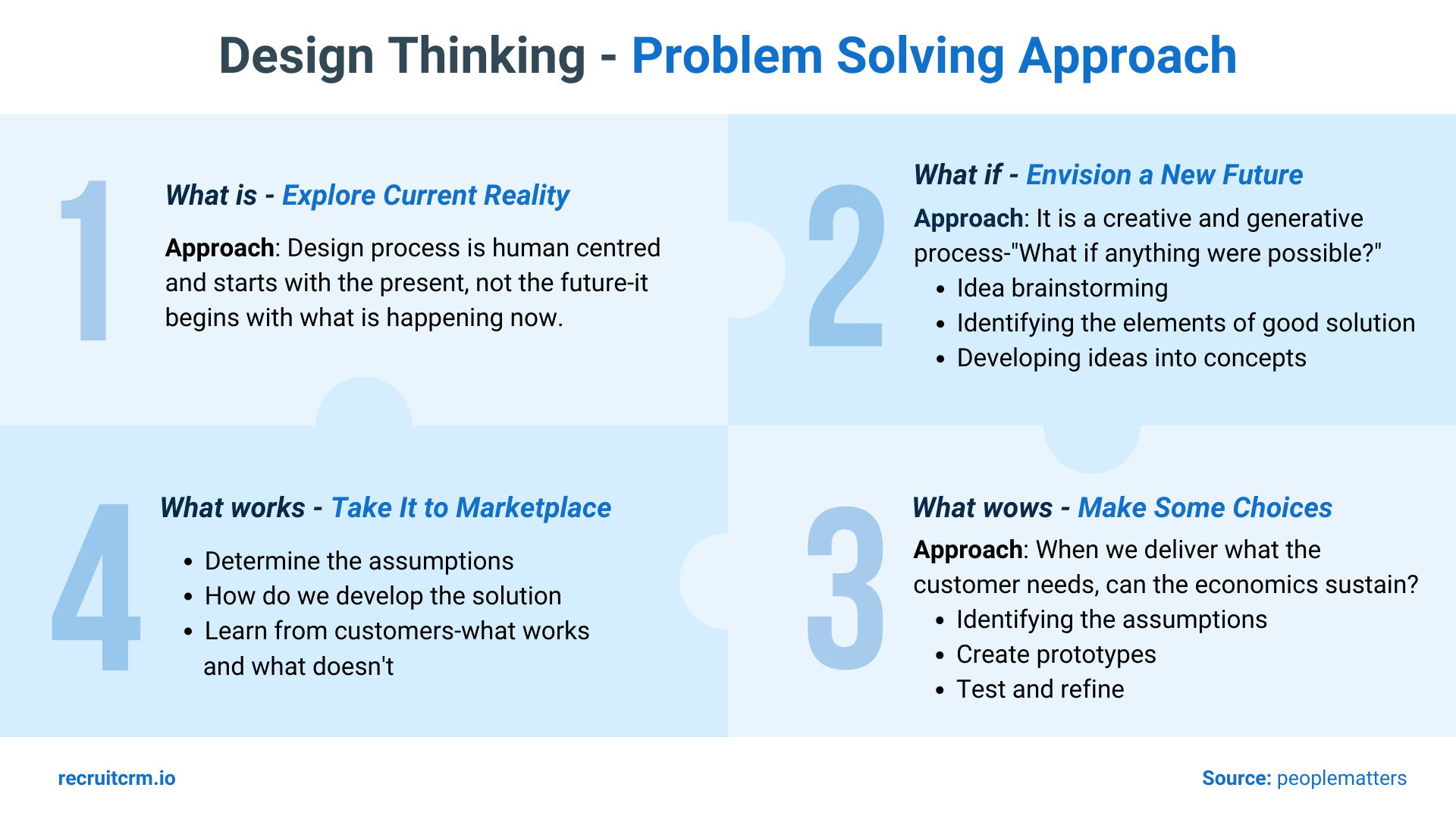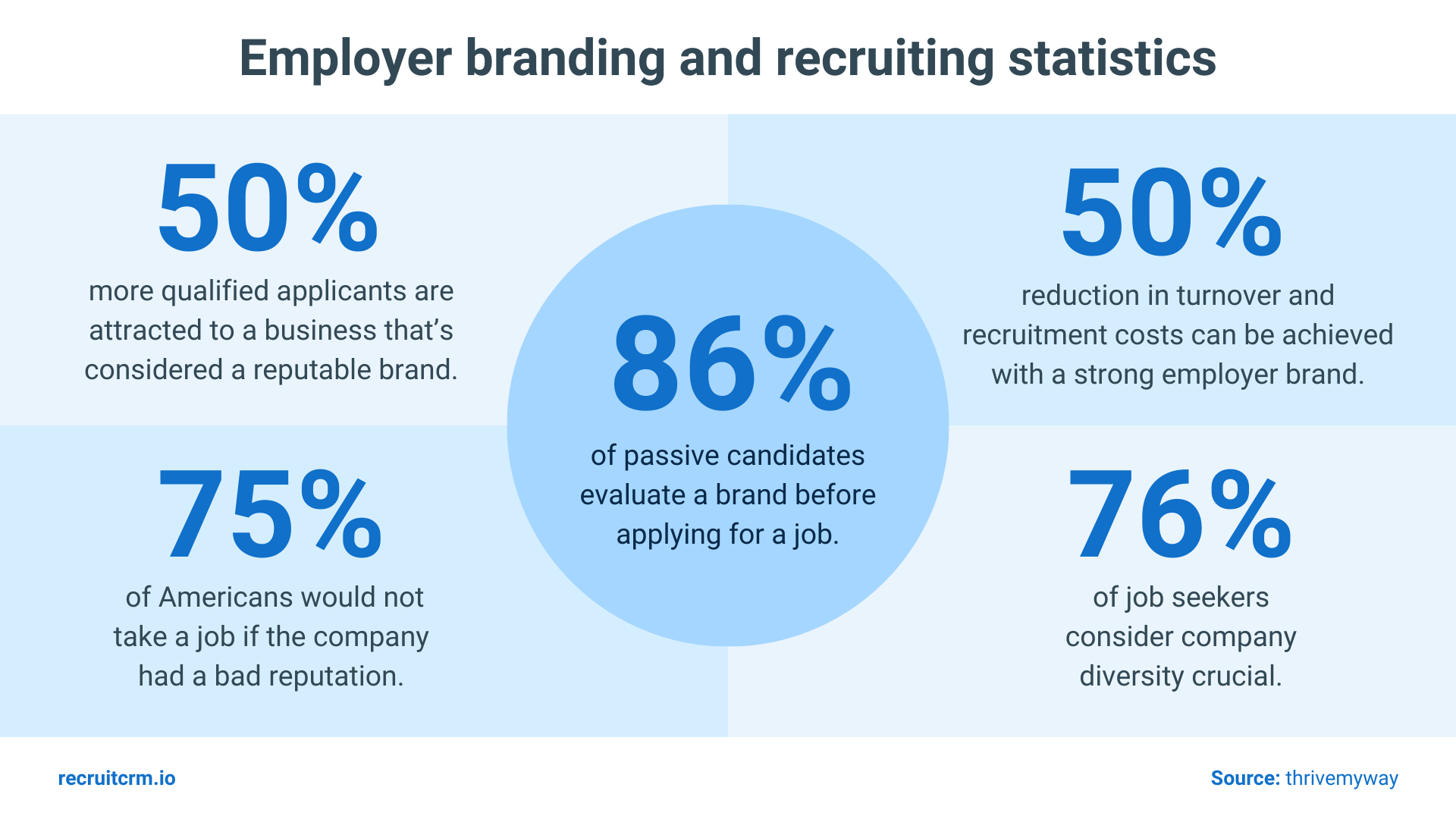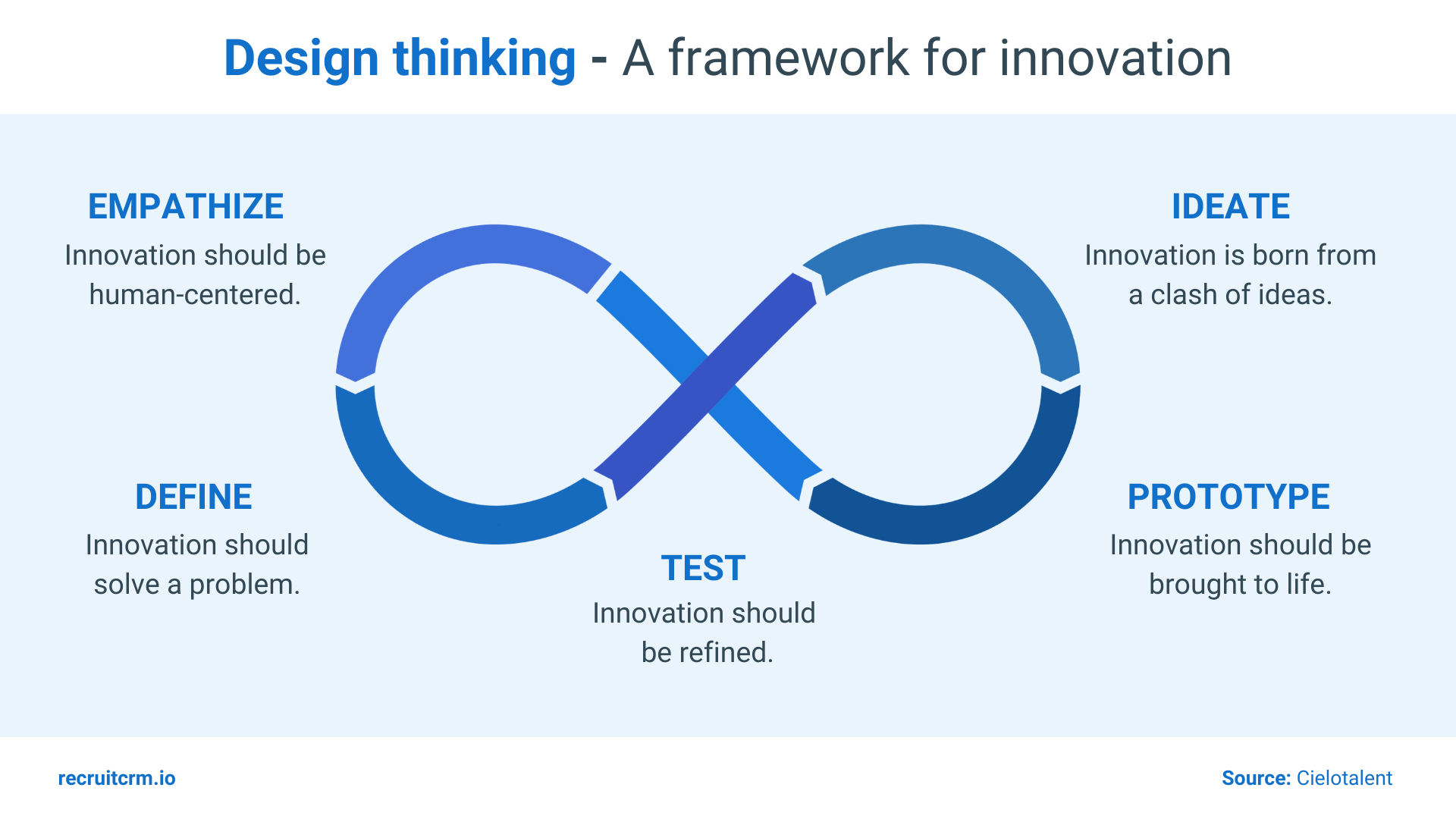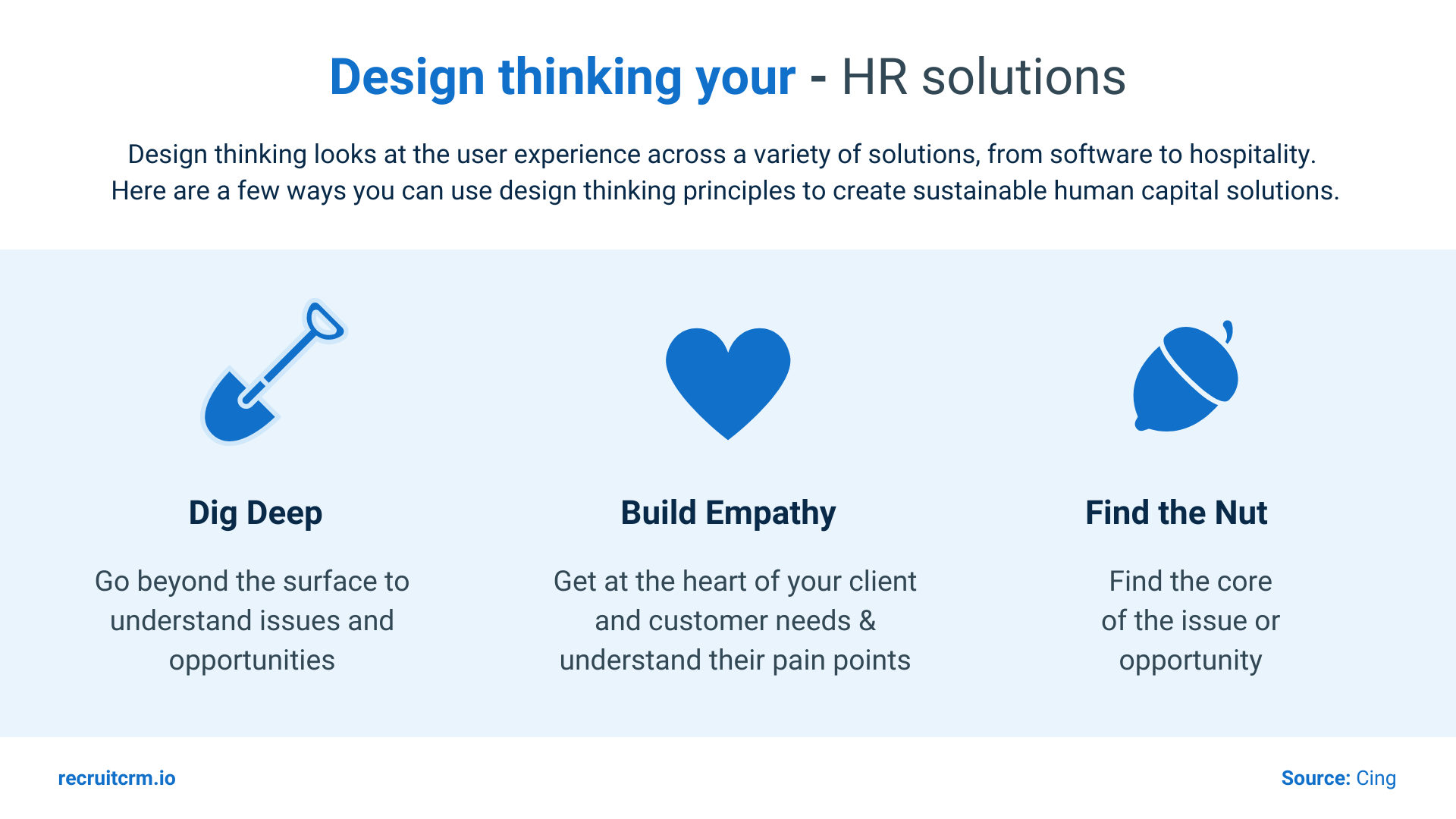Want to make your hiring efforts more human? Then, hear us out on why you should employ a design thinking approach in your recruitment process.
Simply put, design thinking transforms a process-oriented system into a people-oriented one, which can be a key differentiator you NEED today to win the curve.
So, without further ado, let’s discuss DT, its effectiveness, challenges, and implementation steps in detail.
Let’s go!
What is design thinking, and how is it relevant in HR?
Design thinking is a human-centered, iterative problem-solving approach that involves empathy, collaboration, and experimentation to understand the stakeholder’s needs and experiences and find solutions to help them.
Instead of the problem, design thinking considers “who” is impacted by the problem and how to resolve the issue created by it.
For example:
Let’s say a software company is receiving more complaints about its product being “difficult to use” after a major update.
The traditional approach would be to release a user manual or add an FAQ section on the product’s landing page to help users better navigate the “new” product.
But, with design thinking, the company will reach out to its customers to identify their “specific” problems with the update and brainstorm solutions to resolve those issues.
It may-
- Revert certain changes that users found most problematic.
- Introduce an onboarding tutorial for the updated version.
- Re-modify the user interface to make key features more accessible.
With these changes, the company will not only address the immediate complaints but also ensure its software remains user-friendly and intuitive in the long run, keeping its customer base engaged and satisfied.

This framework, though commonly associated with business and product development, is a natural fit for HR’s human-centered role.
By perceiving candidates/employees as ‘customers’ and drawing on their feedback, HR can employ design thinking to curate experiences that resonate with their needs throughout the recruitment process.
Benefits of design thinking in recruitment
Design thinking transforms recruitment from a process-oriented structure to a people-oriented system.
This means all HR-related decisions and processes are based on the employees’ wants and needs rather than prevailing assumptions.
This shift brings a lot of benefits to the table, including:
Improved candidate experience:
Design thinking places the candidates at the heart of the process. By emphasizing their needs, it ensures their experience is positive and memorable.
This “connected” candidate journey translates to loyalty, making them more likely to reapply or refer others in the future.
Enhanced employer branding:
A recruitment process that revolves around “we care about YOU” attracts the most qualified and diverse talent pool. It makes candidates feel valued.
And when candidates feel valued, word spreads – establishing a company as the “employer of choice.”

Increased efficiency:
Design thinking makes the recruitment process more targeted and relevant, leading to better hiring decisions, quicker turnarounds, fewer resources spent on unfit candidates, and more time invested in finding the perfect match.
Better cultural fit:
Design thinking encourages understanding a candidate beyond their CV. It probes into their values, aspirations, and what makes them tick.
This holistic view ensures that hires are skilled and a cultural fit for the company, leading to better team harmony and reduced turnover.
Increased engagement:
Design thinking helps create an interactive and personalized recruitment process. It converts mere passive applicants into engaged participants, fostering more interest in the company and better job acceptance rates.
And guess what? Even candidates who don’t make the cut leave with a positive impression.
Innovative problem-solving:
When recruiters use design thinking, they’re more equipped to think outside the box.
Challenges like reaching passive candidates or dealing with talent shortages become opportunities for innovation, leading to unconventional recruitment methods that might just be the edge a company needs.
Feedback-driven improvements:
Design thinking is iterative. It thrives on feedback.
This ensures the recruitment process is not set in stone but is constantly evolving based on real experiences and needs.
It’s a cycle of continuous improvement that ensures the approach remains current and effective.
In short, as the job market becomes increasingly competitive, design thinking can be the key differentiator companies seek to stand out in the crowd.
What are 5 key phases of design thinking in HR?

The design thinking model is structured around five distinct phases that ensure the recruitment process is holistic, efficient, and human-centered.
These phases are:
1. Empathize – Understand the candidates
This phase focuses on recognizing and understanding the needs and concerns of potential candidates. It’s about breaking away from assumptions and genuinely connecting with the people you aim to hire.
💡How to implement: Conduct surveys, host focus groups, participate in online forums, or attend job fairs.
The point is to engage in open conversation with candidates (including your recent hires and those who declined offers) and understand their aspirations, the environments they thrive in, and the emotions they experience during job hunts.
2. Define – Identify the problem
The second step is to frame the problem statement based on the insights gathered. This statement should resonate with candidates and reflect their concerns, not just your organizational objectives.
💡How to implement: Summarize the findings from your empathy-driven research. Identify the “main” issue.
For instance, if most candidates feel uninformed during the interview process, the problem could be “a lack of clear communication during interview stages.”
3. Ideate – Brainstorm solutions
With a clear understanding of the problem, it’s time to brainstorm diverse solutions. Encourage unconventional thinking, ensuring that the recruitment process remains innovative and adaptive.
💡How to implement: Host collaborative sessions with your team members and HR managers.
Use tools like mind maps or idea boards to brainstorm potential solutions.
Going with the example from the “Define” phase –
The solutions can be –
- Developing a detailed candidate FAQ.
- Creating an informative recruitment journey video.
- Using automation to send timely updates to candidates about their application status.
Fill your idea board with as many suggestions as possible. (Anything to help solve the issue)
4. Prototype – Test potential solutions
Create mock-ups or pilot versions of the proposed ideas. This scaled-down representation will help gauge a solution’s effectiveness before its full-scale implementation.
💡How to implement: From all the suggestions, let’s say you saw the most potential in “Creating an informative recruitment journey video.”
Release it to a select group of candidates first. Gather preliminary feedback and make any necessary tweaks. Only then implement it on a broader level.
5. Test – Refine and implement
This phase calls for refining the solution based on feedback and testing it in real-world conditions.
💡How to implement: Use the initial feedback to optimize the recruitment journey video. Only then, release it to a larger audience.
Also, even after the final release, keep monitoring their effectiveness, gather feedback, and be ready to iterate (all over again) if needed.
These five phases of design thinking, when applied to recruitment, ensure that the hiring process is dynamic, responsive, and always centered around the most important element: the people involved.
It’s an approach that continually seeks improvement, ensuring that your recruitment efforts are always in tune with the needs and expectations of potential hires.
How to apply design thinking in recruitment?
 Begin with the end users in mind, i.e. your candidates. Then, move through each phase we discussed above one by one.
Begin with the end users in mind, i.e. your candidates. Then, move through each phase we discussed above one by one.
While that sounds simple, most talent leaders often forget to involve the candidate’s feedback when coming up with solutions.
And the result is… bad hires?… failed services?… unsatisfied clients?… or everything at once?
Because HR is responsible to bring human experience into business operations, design thinking framework can help them prioritize workforce perspective and experience.
Here are five domains HR can implement design thinking in recruitment:
Recruitment process
- Streamline the recruitment journey to make it more candidate-friendly. This calls for cutting down all unnecessary steps and introducing more interactive elements.
- Post-recruitment, send feedback forms to candidates – whether they were hired or not to gather their insights.
Onboarding experience
- Design an onboarding process that educates, welcomes, and engages new hires. It should answer everything a new hire must know to succeed.
- Use multimedia resources like videos or interactive quizzes to foster employee engagement.
- Set up regular check-ins during the initial months to address any concerns or questions.
Training and development
- Recognize that each employee has unique career aspirations. Design development plans that are in sync with these individual goals. This might entail offering different modes of training or personalizing content.
- Post-training, gather feedback to understand what worked and what didn’t. Use this to refine future training sessions.
Employee feedback and engagement
- Foster a culture where feedback isn’t just encouraged but is actively sought. Use this to make informed decisions about company policies, work culture, etc.
- Implement platforms or tools where employees can anonymously share feedback. And periodically review them with a team to take actionable steps.
Performance management and appraisals
- Ensure employees are crystal clear about their roles and responsibilities. It will eliminate ambiguity and create a more productive work environment.
- Not everyone is a top performer right from the start. For those who need a little extra help, craft individualized improvement plans rather than using generic training modules.
- Implement consistent one-on-one sessions, allowing employees to ask questions, voice concerns, and get direct feedback.
Remember, implementing design thinking in recruitment requires proper resources, budget, and even a plan for upskilling your HR team.
Though you may find it difficult at first, understanding its principles and phases will help.
Challenges associated with implementing design thinking in recruitment [+ Mitigation tips]
Indeed, design thinking in recruitment promises numerous benefits. However, it also brings with itself a few challenges, like:
1. Resistance to change
Humans are creatures of habit, and the recruitment sector is no different. Existing recruitment practices, deeply entrenched in traditional processes, can be hard to shake off.
Mitigation tip: Start by promoting a culture of openness and continuous learning. Organize workshops or training sessions emphasizing the benefits of design thinking. Real-life case studies can be instrumental in highlighting its practical value.
2. Insufficient understanding of the design thinking framework

Misunderstanding or partial knowledge of design thinking can lead to misapplication, reducing effectiveness.
Mitigation tip: Invest in training programs. Encourage team members to attend design thinking seminars or online courses. An educated team will be more adept and confident in their new approach.
3. Time and resource constraints
Design thinking, especially in the early stages, can seem time-consuming. It involves brainstorming, prototyping, testing, and iterating — processes that can strain resources.
Mitigation tip: Highlight the long-term value. While initial stages might be resource-intensive, the results — like better talent fit and reduced turnover — can be time and cost-saving in the long run.
4. Overemphasis on empathy
While empathy is a cornerstone of design thinking, an excessive focus can sometimes overshadow other essential aspects, like skills or experience.
Mitigation tip: Balance is key. Use design thinking to understand the candidate holistically, but ensure that qualifications and experience are weighed appropriately in the final decision.
5. Fear of failure
As design thinking encourages experimentation, not all endeavors will meet with success. This fear can hamper your HR team’s willingness to try new methods.
Mitigation tip: Promote a culture where failures are seen as learning opportunities. Iterate based on feedback and understand that every misstep is a step closer to refining the process.
6. Inconsistent implementation
If not universally adopted within the HR department, the sporadic use of design thinking can lead to inconsistent recruitment experiences.
Mitigation tip: Create standardized guidelines and ensure all team members are on the same page. Regular check-ins and reviews can ensure consistency.
7. Feedback overload
One of the pillars of design thinking is constant feedback. However, if not managed correctly, this can lead to overwhelming information.
Mitigation tip: Use structured channels for feedback. Employ tools to help sort, categorize, and prioritize feedback to extract actionable insights effectively.
In short, employ a proactive approach and a focus on continuous improvement. That’s it. You are good to go!
Frequently asked questions
Q1- What are the key principles of design thinking in recruitment?
The key principles of design thinking in recruitment are:
- Empathy: Understanding the needs and experiences of candidates.
- Human-centeredness: Putting people at the center of the recruitment process.
- Collaboration: Working with candidates, hiring managers, and other stakeholders to create the best possible experience.
- Experimentation: Trying new things and learning from mistakes.
- Iteration: Continuously improving the recruitment process based on feedback.
Q2 – How does design thinking differ from traditional recruitment methods?
Traditional recruitment often focuses on filling vacancies and matching skill sets with job requirements.
In contrast, design thinking emphasizes understanding the candidate’s aspirations, values, and potential fit within the company culture. It encourages iterative feedback and continuous improvement in the recruitment process.
Q3 – Isn’t design thinking time-consuming? How can it make the recruitment process efficient?
While the initial stages of integrating design thinking might seem more time-intensive due to brainstorming and experimentation, it often results in a more streamlined process in the long run.
By deeply understanding candidate needs and continuously refining the process, companies can reduce mis-hires, improve retention, and ensure a smoother hiring process.
Q4 – How can companies start integrating design thinking into their recruitment processes?
Start by training the HR and recruitment teams about design thinking principles.
Engage in empathy-building exercises to better understand candidates, encourage brainstorming sessions for innovative recruitment strategies, and regularly seek feedback from candidates and hiring managers to refine the process.
Q5 – Does design thinking in recruitment only benefit the candidates?
While design thinking significantly emphasizes the candidate experience, its benefits are dual-sided.
Companies benefit by attracting better-fit talent, improving their employer brand, reducing turnover costs, and fostering a positive reputation in the job market.




